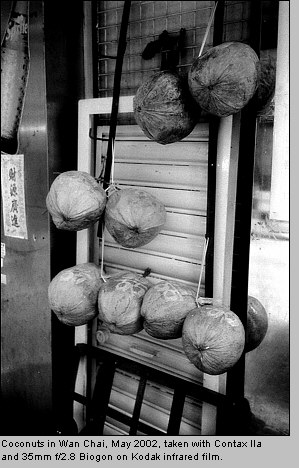The History of the Contax
.jpg) The origins of the Contax are tied to another
German camera: the Leica. Ernst Leitz revolutionized photography in 1926 with its then-"miniature" camera that used 35mm motion-picture film,
rather than plates or sheet film.
The origins of the Contax are tied to another
German camera: the Leica. Ernst Leitz revolutionized photography in 1926 with its then-"miniature" camera that used 35mm motion-picture film,
rather than plates or sheet film.
This was a significant development. At this time, most photographers used either plate- or roll-film cameras. Plate-film photographers usually carried a small box or crate that held the camera, one or possibly two lenses, a collection of preloaded plates and of course a heavy wooden tripod, as if there were any other kind. No small wonder that most photographers were men. Women, rightly so, had better sense than to want to drag that kind of gear out to the countryside.
.jpg) The roll-film photographer had it easy by
comparison, only needing the camera and several rolls of film and possibly a
tripod. Film speeds were still very slow. The fastest film on the market would be considered
extremely slow today -- rated at today's equivalent of ISO 25 or even
lower. Most films
in the early part of the century were even slower than that.
The roll-film photographer had it easy by
comparison, only needing the camera and several rolls of film and possibly a
tripod. Film speeds were still very slow. The fastest film on the market would be considered
extremely slow today -- rated at today's equivalent of ISO 25 or even
lower. Most films
in the early part of the century were even slower than that.
Regardless of the camera being used, taking a photo took time -- and usually lots of time. You can understand why there are so many grim faces peering out from photos that were taken in the early part of the century.
Early Leica users didn't get off the hook that easy. Kodak's daylight-loading cartridge was still several years away. Photographers had to buy lengths of film and cut and then load it into small brass cassettes.
 Sure, it was a time-consuming process, but once out in the
field, a photographer could slip several preloaded cassettes into the pocket
of a jacket and shoot
maybe 100 pictures in a day. Compare that with the handful of shots
possible by most plate- and roll-film cameras. And without having to lug
around pounds and pounds of equipment, the Leica photographer was a very
happy person.
Sure, it was a time-consuming process, but once out in the
field, a photographer could slip several preloaded cassettes into the pocket
of a jacket and shoot
maybe 100 pictures in a day. Compare that with the handful of shots
possible by most plate- and roll-film cameras. And without having to lug
around pounds and pounds of equipment, the Leica photographer was a very
happy person.
The Leica blazed the path by making it possible for a photographer to shoot many photos quickly, silently and unobtrusively. It forever changed photography and how photographers were viewed, in the same way that Kodak's box camera changed photograpy.
For a number of years, the Leica ruled this market by itself. Its success did not go unnoticed, and it was clear that others soon would follow Leica's lead -- even Kodak.